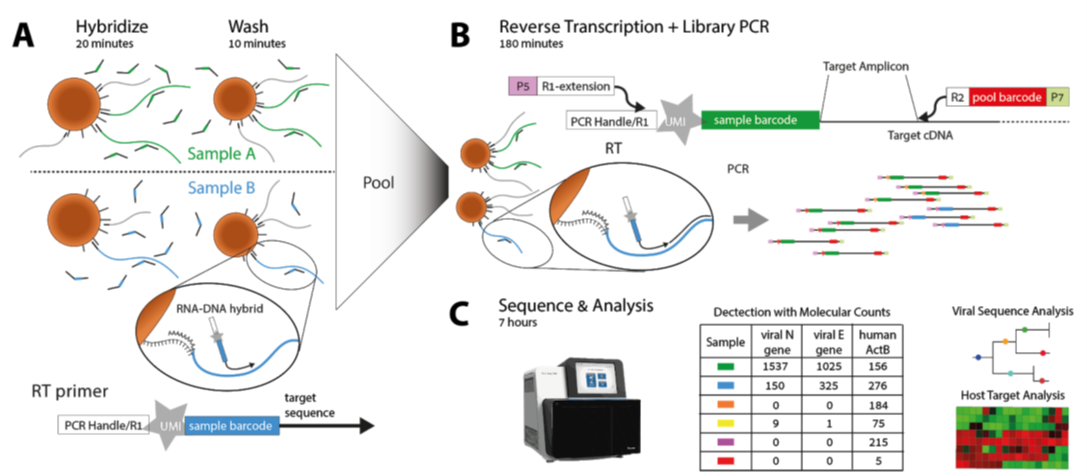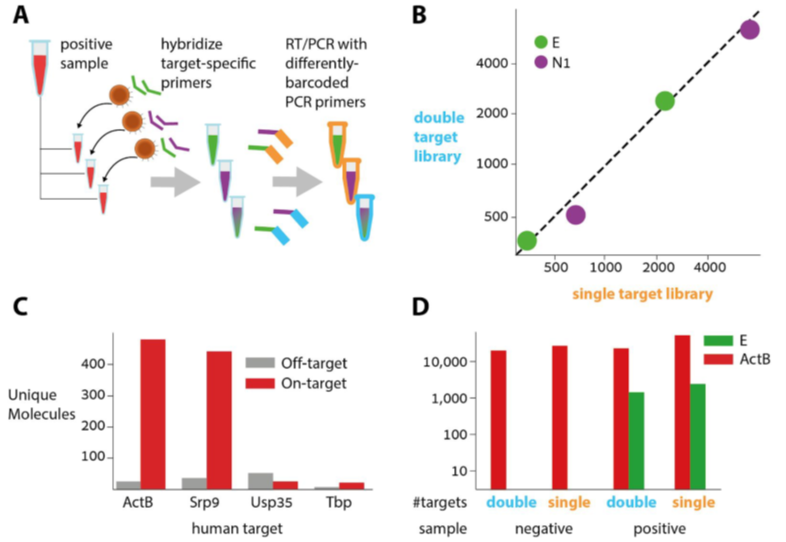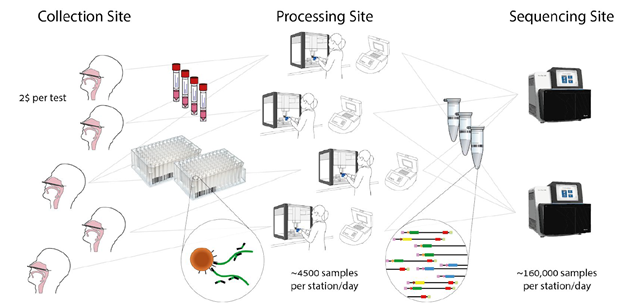2020-09-28 by Quick Biology Inc.
Countries across Europe especially France, the UK, and Poland are seeing a resurgence in COVID-19 cases, are likely dealing with the much-feared second wave of SARs-CoV2 recently. Quick Biology previously summarized three methods which used next generation sequencing, to do high throughput diagnostics. Most of these amplicon NGS libraries are based on RNA extraction followed by PCR; LAMP-seq, although getting rid of RNA extractions, combining isothermal nucleic acid amplification, its dynamic range/quantitative measure is still under evaluation (see News in Quick Biology). ApharSeq is a significant improvement in existing RNA-seq detection protocols. This method is developed by researchers in Israel. In their workflow, they combined 1) RNA-extraction free, samples are lysed in transport/lysis buffer; 2) RNAs are captured individually by barcoded RT primers for each patient; 3) pre-hybridized target-RT primer samples are pooled and undergo and RT and PCR with another strand of virus-specific primer with pool barcoding sequences; 4) Final amplicon with P5 and P7 end are sequenced in Illumina platform (ref1, Fig.1).
Highlights of ApharSeq:
- 1. Two barcoding (sample barcoding and pool barcode) strategy dramatically reduces the cost and increases the scalability of patient screening. (Fig.1)
- 2. ApharSeq is quantitative using NGS reads counting (Fig.2).
- 3. ApharSeq can do multiplexing primers in RNA capture, which means testing many genes of SARS-CoV2 in a single run, increases the power of statistical call. (Fig.3)
- 4. ApharSeq is uniquely poised to allow tests at a massive scale, for both the low cost and minimal labor requires. (Fig.4)
Figure 1: ApharSeq overview (Ref 1).
A) Barcoded and uniquely-identifiable RT primers are hybridized to samples in transport/lysis buffer or after a quick buffer replacement step. Paramagnetic beads are used to capture RNA and wash excess primers. B) Beads are pooled, and RNA undergoes an RT/PCR reaction with pre-hybridized target-specific primers to generate a sequencing library. C) Libraries are sequenced and analysed, PCR duplicates are collapsed to molecular counts for detection and potentially more elaborate analyses, e.g. contact tracing by viral sequence analysis, host physiological state by mRNA analysis.

Figure 2: ApharSeq is quantitative and sensitive compared to RT-PCR.
A) Target titration experimental scheme. SARS-CoV-2 positive sample is diluted in lysis buffer. Diluted samples are hybridized to barcoded ApharSeq primers (interior tube color), and split so they can be assayed separately or pooled. Samples are subjected to PCR with different barcodes (red/green) to distinguish their treatments. B) Assay is linear in both cases (p-value < 0.001). The linearly extrapolated LoD for pooled samples is ~Ct 35.7 and is 4 times lower than the LoD for the single samples (methods). C) Low target titration experiment, in which we also introduced a viral target control for quantification (methods) shows the actual LoD is ~680 molecules/ml (Ct ~37.4). D) Limit of detection as a function of Sequencing Depth as derived by down-sampling the sequencing reads (methods). The highlighted bar (~25,000 reads per sample) corresponds to data in C.

Figure 3: Multi-target ApharSeq libraies (ref1).
A) Multiple target assay scheme. A positive sample was split and hybridized with E, N1, or E+N1 RT primers. These samples underwent ApharSeq with differently-barcoded PCR primers to delineate reads from the double/single hybridization conditions. B) Target Multiplexing Results. ApharSeq libraries for high/medium viral load samples for the N1 and E amplicon separately (x-axis) yield similar counts to a single ApharSeq library for both targets (y-axis). Units are unique molecular counts. C) Human Target Tests for multiple genes on a pool of negative samples highlight potential specific targets at different expression levels (see all targets tested in Figure S3). D) Human and viral targets multiplexed in the same ApharSeq library (“double”) allow for internal control in negative/positive samples. Units are unique molecular counts.

Figure 4: High Throughput testing at less than $2 per test.
They propose a division of labor scheme where any facility that has an automated liquid handler and a PCR block can function as a first step in the processing pipeline. A single 96 plate is processed and pooled every ~30 minutes in every such station. These pooled batches can be collected to a central sequencing facility that pools them further for cost-effective sequencing. If collection into plates is not feasible, there are dedicated automated liquid handler stations for re-organizing tubes into plates, as is already the case in most testing facilities.

Quick Biology is an expert in NGS applications. Find More at Quick Biology.
Ref:
- Chappleboim A, Joseph-Strauss D, Rahat A et al. (2020) ApharSeq: An Extraction-free Early-Pooling Protocol for Massively Multiplexed SARS-CoV-2 Detection. medRXiv (https://www.medrxiv.org/content/10.1101/2020.08.08.20170746v2)



